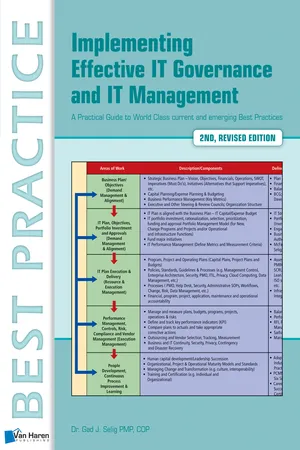![]()
Part I of the book covers chapters 1 through 4. It focuses on an overview of IT governance, alignment and strategy, leadership teams, organization and managing change. It also references current and emerging best practice industry frameworks, guidelines and standards that are useful and applicable to IT management and governance and its major components.
![]()
On Change and Innovation:
“Never be afraid to try something new.
Remember, amateurs built the Ark, professionals built the Titanic!”
Anonymous
■ 1.1 WHAT IS COVERED IN THIS CHAPTER?
■ Provide an overview and summary of the key business/IT planning, execution, governance issues, constraints, opportunities and processes;
■ Discuss the roles of the board, and responsibilities of executive management and the CIO;
■ Review the value propositions for IT governance;
■ Provide an overview of IT demand management, decision rights, balanced scorecard metrics and how much governance is really required;
■ Identify steps in making IT governance real and pragmatic;
■ Discuss an assessment technique to determine the current level of IT governance maturity in an organization and illustrate a blueprint of an ideal, future target state of IT governance.
■ 1.2 OVERVIEW
The issues, opportunities and challenges of aligning information technology more closely with an organization and effectively governing and managing an organization’s Information Technology (IT) investments, resources, major initiatives and superior uninterrupted service are becoming a major concern of the board and executive management in enterprises on a global basis. IT has become a critical function in most organizations and is fundamental to support, and sustain innovation, growth and survival.
Therefore, a comprehensive top-down approach with bottom-up execution of IT governance, a key component of enterprise governance, which includes all the activities of business/IT alignment, planning, execution, management, control and governance of IT as well as the leadership of those entrusted with the task, is critical to achieve a cost effective solution and approach. Effective ‘management’ includes the activities of planning, investment, integration, measurement, deployment and providing the services required to manage a complex and valuable strategic asset. Enterprise governance represents the entire management accountability and control framework of an organization, including roles and responsibilities of the board, the CEO and other functional managers, to ensure that the organization meets its objectives and plans in an ethical manner. Enterprise governance and corporate governance are terms used interchangeably.
None of this is easy, or obvious, and this pragmatic and actionable ‘how to guide’ is intended to draw from over 500 current and emerging best practice sources and over twenty-five IT governance best practice case studies, some of which are included in the book.
The purpose of the book is not to repeat in greater detail, what has been published previously, but to describe each of the major IT governance components as part of an overall comprehensive framework and roadmap in sufficient detail for executives, managers and professionals to serve as a guideline and starting point for any size organization in any industry to develop and tailor a workable and realistic approach to its environment, strategies, priorities, capabilities and available resources, and to transition IT organizations to a higher level of maturity, effectiveness, responsiveness and management.
1.2.1 Today’s business challenges and drivers
Our world is in a time of remarkable and sometimes overwhelming change. The pace of change is accelerating on a global basis. Pressures for reducing costs, increasing speed to market, continuous improvements, greater innovation and creativity, more compliance, more effective accountability, globalization and more demanding and sophisticated customers are some of the pressures facing business and IT executives.
Figure 1.1 illustrates select pressures and drivers that organizations must deal with in a rapidly and dynamically changing global environment.
1.2.2 Scope and definition of enterprise governance and its relationship to business and IT governance
The discipline of enterprise governance begins at the top. The critical questions here are: How is a corporation’s board of directors structured? Does it operate in a way that ensures their ability to fulfill their obligation to safeguard the resources of the company and the interests of corporate stakeholders?
Figure 1.1 Today’s business challenges
Effective corporate governance requires the board to focus on general oversight and stewardship of the corporation, and to refrain from involvement in the day-to-day operations of the company. In this way, the board is able to maintain an integrated and relatively objective perspective on the company’s operations, which helps it to steer the firm in the direction that will most benefit not only shareholders, but also the corporation in its entirety (Lam, 2014).
According to the International Federation of Accountants (IFAC), “Enterprise governance constitutes the entire accountability framework of the organization.” Enterprise governance is the set of responsibilities and practices exercised by the board and executive management with the goal of providing strategic direction, ensuring that plans and objectives are achieved, assessing that risks are proactively managed and assuring that the enterprise’s resources are used responsibly.
In an increasingly information technology-dependent world, the impact of the extraordinary changes brought about by the nexus of mobile and cloud technologies, social media and big data is increasingly being felt in the board room. As leaders of enterprises of every type and size, board directors can no longer afford to ignore, delegate or avoid IT-related decisions. Competitive, financial and reputational risk is increased if boards fail to recognize their role in governing technology as an asset and in removing barriers to improving enterprise information technology governance. Directors’ awareness of the need for IT governance is increasing.
Enterprise governance includes the leader...



